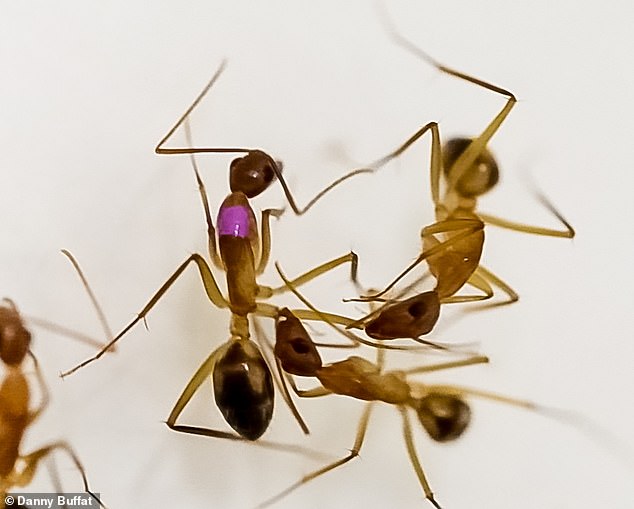With their incredible intelligence and organizational skills, it’s no secret that ants are one of the smartest insects in nature.
But a new study shows that their capabilities even extend to performing life-saving operations on their fellow soldiers.
Researchers have discovered that ants perform procedures on their nestmates to save them from infection and possible death.
A remarkable video shows healthy ants helping their friends who have a leg injury, either by cleaning the wound or amputating it.
Ants can survive with one or even two legs missing, although their ability to carry leaves, twigs or food is affected.
Laboratory experiments show that Florida carpenter ants treat the injured limbs of their nestmates, either by cleaning the wound or amputating it (pictured)
The new study was led by Dr. Erik Frank, a behavioral ecologist at the University of Würzburg in Germany, and published in Current biology.
“The fact that ants are able to diagnose a wound, see if it’s infected or sterile and treat it accordingly over long periods of time by other individuals, the only medical system that can rival that would be the human one,” Dr. Frank said.
He and his colleagues specifically studied Florida carpenter ants (Camponotus floridanus), a common, brown species native to the southern U.S. state.
In laboratories at the University of Lausanne in Switzerland, researchers cut selected ants’ right hind limbs, leaving them at risk of infection.
The team observed the behavior of their nestmates for about a week, while filming them closely.
They found that nestmates either performed wound cleaning with their mouthparts alone or performed cleaning followed by complete leg amputation.

This undated photograph shows two carpenter ants, Camponotus fellah, in a laboratory at the University of Lausanne, Switzerland. The ant on the right is licking the wounds on an injured leg of the other ant.

The research team found that the ants’ choice of care was tailored to the type of injury they suffered. Here, the ant on the right is nursing the leg wound of the ant on the left.
Surprisingly, the ants appeared to assess the injury to decide which procedure to perform, like a trained doctor assessing a patient.
When an ant injured a leg in a segment called the femur, its nestmates would amputate the leg by biting it.
But when the injury was on the tibia, a segment further away from the body, the insects concentrated on cleaning their mouths.
In both cases, the intervention of nestmates resulted in ants with infected wounds having a much higher survival rate.
Femur injuries, where the leg was always amputated, had a success rate of about 90 or 95 percent.
In the tibia, where no amputation was performed, a survival rate of around 75 percent was still achieved.
“This contrasts with the survival rate of less than 40 and 15 percent for untreated infected femur and tibia abrasions, respectively,” Dr. Frank said.
It is thought that the preferred route of wound care may be related to the risk of infection at the wound site.
Micro-CT scans of the femur showed that it is largely composed of muscle tissue, suggesting it plays an important role in pumping blood to the rest of the body, so the risk of a lethal infection due to a femur injury is likely higher.

This graphical summary shows amputation and wound care behavior in Florida carpenter ants (Camponotus floridanus).
Ants are often described as the most intelligent of all insects and may even possess some level of self-awareness.
But researchers believe the ability to help a nestmate is natural and is an “innate behavior.”
“Ants’ behavior changes with the age of the individual, but there is very little evidence of learning,” said lead author Laurent Keller of the University of Lausanne.
Ant wound care isn’t an entirely new phenomenon: A 2023 study found that a different species, Megaponera analis, uses a special gland to inoculate wounds with antimicrobial compounds meant to smother potential infections.
But the authors of this new study say that Florida carpenter ants are special because they don’t have such a gland and so they use only mechanical means to treat their nestmates.
“When we talk about amputation behavior, this is literally the only case where sophisticated, systematic amputation of an individual by another member of its species occurs in the animal kingdom,” Dr. Frank said.


